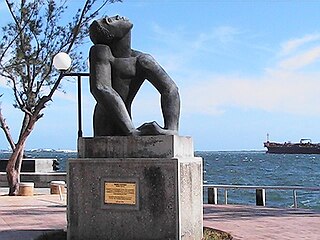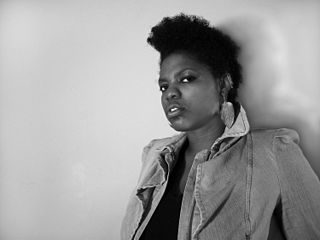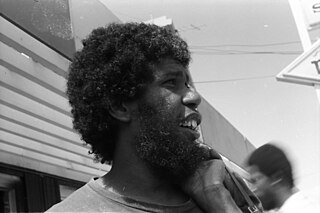Related Research Articles

The National Gallery of Jamaica, in Kingston, Jamaica, is Jamaica's public art museum. It was established in 1974 and is located in the Kingston Mall, a commercial and cultural center on Kingston harbour. The National Gallery of Jamaica also has a branch in Montego Bay, National Gallery West.

In the art world, a biennale, is a large-scale international contemporary art exhibition. The term was popularised by the Venice Biennale, which was first held in 1895, but the concept of such a large scale, and intentionally international event goes back to at least the 1851 Great Exhibition in London. The 1990s saw the boom of art biennials, a period of multiplication of this exhibition form during which art biennials grew from approximately five to over 250 internationally.

Edna Swithenbank Manley, OM is considered one of the most important artists and arts educators in Jamaica. She was known primarily as a sculptor, although her oeuvre included significant drawings and paintings. Her work forms an important part of the National Gallery of Jamaica's permanent collection, and can be viewed in other public institutions in Jamaica such as Bustamante Children's Hospital, the University of the West Indies, and the Kingston Parish Church.
Kimathi Donkor is a London-based contemporary British artist whose paintings are known for their exploration of global, black histories. His work is exhibited and collected by international museums, galleries and biennials including London's National Portrait Gallery, the British Museum, the Diaspora Pavilion at the 57th Venice Biennial, the 29th São Paulo Art Biennial and the 15th Sharjah Biennial. He is of Ghanaian, Anglo-Jewish and Jamaican family heritage, and his figurative paintings depict "African diasporic bodies and souls as sites of heroism and martydom, empowerment and fragility...myth and matter".

Keith Anthony Morrison, Commander of Distinction (C.D.), born May 20, 1942), is a Jamaican-born painter, printmaker, educator, critic, curator and administrator.

Ebony Grace Patterson is a Jamaican-born visual artist and educator. She is known for her large and colorful tapestries created out of various materials such as, glitter, sequins, fabric, toys, beads, faux flowers, jewelry, and other embellishments. Her "Gangstas for Life series" of dancehall portraits, and her garden-inspired installations.

Jamaican art dates back to Jamaica's indigenous Taino Indians who created zemis, carvings of their gods, for ritual spiritual purposes. The demise of this culture after European colonisation heralded a new era of art production more closely related to traditional tastes in Europe, created by itinerant artists keen to return picturesque images of the "new world" to Europe. Foremost among these were Agostino Brunias, Philip Wickstead, James Hakewill and J. B. Kidd.
Caribbean art refers to the visual as well as plastic arts originating from the islands of the Caribbean. Art in the Caribbean reflects thousands of years of habitation by Arawak, Kalinago, and other people of the Caribbean followed by waves of immigration, which included artists of European origins and subsequently by artists with heritage from countries all around the world. The nature of Caribbean art reflects these diverse origins, as artists have taken their traditions and adapted these influences to reflect the reality of their lives in the Caribbean.

Edna Manley College of the Visual and Performing Arts,, is an art school in Kingston, Jamaica. In 1940, Edna Manley pioneered evening art classes at the Institute of Jamaica's Junior Centre but it was not until 1950 that the first formal arts school opened at the DaCosta Institute at 1 Central Avenue, Kingston Gardens. A number of leading Jamaican artists collaborated with Manley to open the first art school in Jamaica, including Albert Huie who became one of the tutors. 64 paying students enrolled in the first year and due to unexpected interest expanded the school at 11 North Street.

Graham Fagen is a Scottish artist living and working in Glasgow, Scotland. He has exhibited internationally at the Busan BiennaleArchived 10 September 2013 at the Wayback Machine, South Korea (2004), the Art and Industry Biennial, New Zealand (2004), the Venice Biennale (2003) and represented Scotland at the 56th Venice Biennale in 2015 in a presentation curated and organised by Hospitalfield. In Britain he has exhibited at the Victoria & Albert Museum, Tate Britain and the Institute of Contemporary Arts, London. In 1999 he was invited by the Imperial War Museum, London to work as the Official War Artist for Kosovo.

Kofi Kayiga, formerly known as Ricardo Wilkins, is a Jamaican-born artist and educator, who migrated to the US, after periods spent in the UK and Uganda. He has exhibited widely internationally and since the 1960s has taught fine art at various institutions, becoming a professor at the Massachusetts College of Art and Design (MassArt).
Petrona Morrison is a Jamaican sculptor and media artist. Her work is largely inspired by African art; she uses found objects in assemblages that have both personal and broader social themes.
Hope Brooks is a Jamaican painter. Many of her works consist of multiple panels, and are designed to be exhibited installation-style. Her works are mainly abstract, but many contain political themes as well.
The Ghetto Biennale is an international contemporary arts exhibition held every two years in Port-au-Prince, Haiti during November and December.

Vladimir Cybil Charlier is an American visual artist who lives and works in New York City. Her works reflect the complex dynamics linking two important geographic markers: The Caribbean and the United States. Her parents' migration into the United States allowed her to receive an education in fine arts and become a mix media artist. Her work includes paints, drawings, sculptures and others. Today she has a variety of work collections that have been displayed in numerous exhibitions within the United States and abroad.

Camille Norment is an Oslo-based multimedia artist who works with sound, installation, sculpture, drawing, performance, and video. Norment also works as a musician and composer. She performs with Vegar Vårdal and Håvard Skaset in the Camille Norment Trio.

Laura Facey CD is a Jamaican contemporary artist. She is best known for the monumental sculpture Redemption Song (2003), which serves as Jamaica's national monument to the Emancipation from Slavery.
Nadia Huggins was born in 1984 in Port of Spain, Trinidad and Tobago. She now resides in Saint Vincent and the Grenadines. Nadia Huggins is a self-taught photographer and graphic designer who has worked extensively throughout the Caribbean. She was awarded the Festival Caribbeen de L'image du Mémorial Acte Jury Prize in Guadeloupe in 2015.
Cecil Archibald Baugh, was a Jamaican master potter and artist.
Donnette Ingrid Zacca is a Jamaican fine art photographer, lecturer, and artist. The Jamaican Magazine and the National Gallery of Jamaica have listed her among the best photographers in the nation. She has exhibited at the National Gallery's Biennial and was the recipient of the Institute of Jamaica's Silver Musgrave Medal in 2015.
References
- ↑ Rubis, InPulse (2018). InPulse Collective Kingston. Kingston, Jamaica: Rubis.
- 1 2 "Bio". Camille Chedda. Retrieved 2021-05-12.
- ↑ NGJ, National Gallery of Jamaica (2017). 2017 Jamaica Biennial Catalogue. Kingston, Jamaica: National Gallery of Jamaica.
- ↑ Anderson, Kat; Evelyn, Graeme Mortimer (2016). Jamaican Pulse. Bristol, England: Sansom and Company. ISBN 978-1-908326-95-9.
- ↑ "Hospitalfield". Hospitalfield. Hospitalfield. Retrieved December 22, 2018.
- 1 2 NLS, New Local Space. Insides, NLS. Kingston, Jamaica: New Local Space.
- ↑ "2017 British Council TAARE Artist Camille Chedda". 2017 British Council TAARE Artist Camille Chedda. Retrieved December 22, 2018.